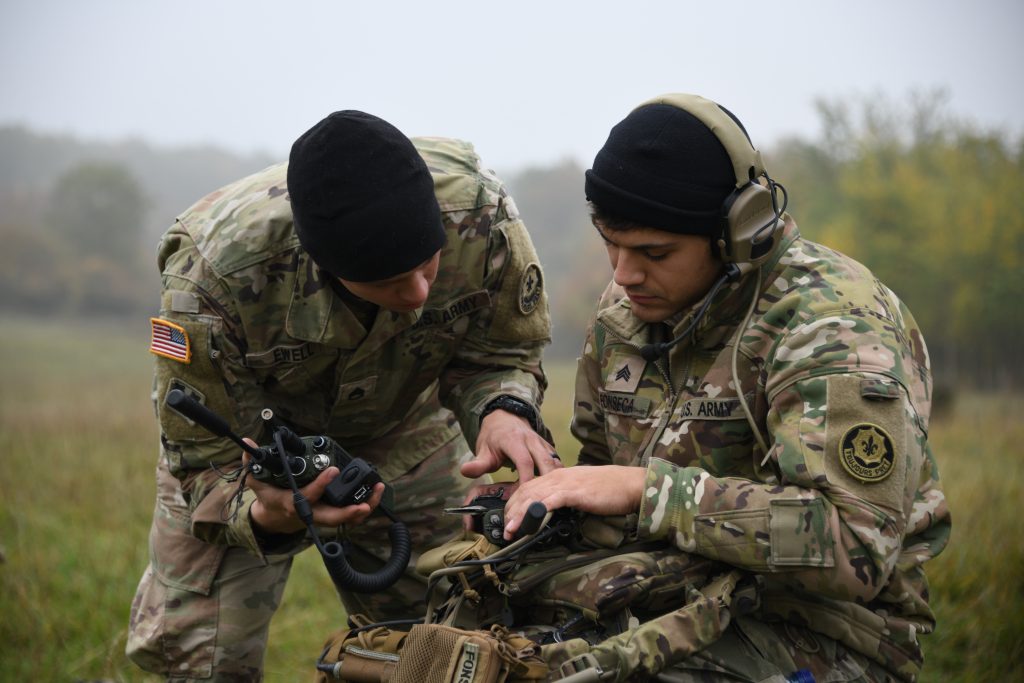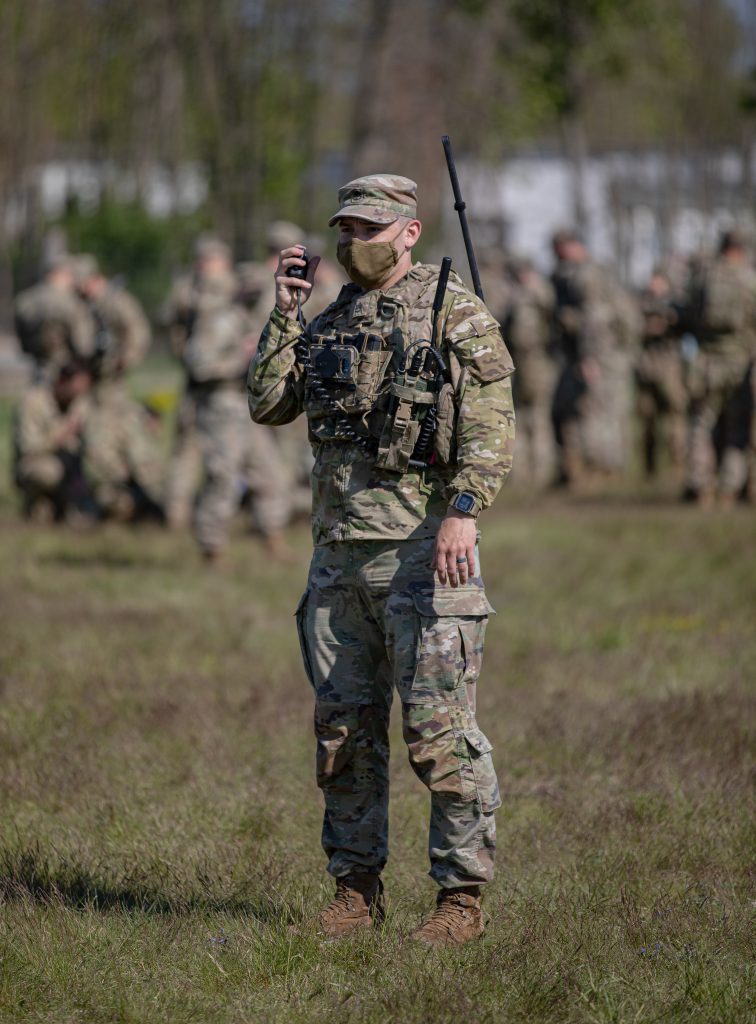
SUMMER PLANS: The Army will conduct a Satellite Communications (SATCOM) as a Managed Service (SaaMS) Pilot this summer to inform decisions on the service’s potential use of a commercially leased SATCOM network equipment and bundled services model, which would be flexible and tailorable to changing mission needs. (Graphic by U.S. Army)
The SaaMS pilot will study the Army’s potential use of a commercially leased network equipment and bundled services model.
by Lt. Col. Mark Scott, Tyler J. Cook and Amy Walker
In today’s complex geopolitical landscape, the Army needs to deliver resilient network connectivity to multiple disparate locations globally in support of diverse and continually changing missions. U.S. forces must always be prepared to fight across different fronts, terrains and climates, such as those in Europe, the vast islands of the Pacific or frozen Arctic landscapes. Simultaneously, DOD must sustain this vast arsenal of network equipment across the force and constantly modernize it to keep pace with technology and ensure success against sophisticated adversaries. This comes with a heavy price tag.
One way the Army is looking to overcome these challenges is through innovative new business models, including satellite communications (SATCOM) as a managed service (SaaMS), which the Army is preparing to pilot this summer. The SaaMS pilot will inform decisions on the service’s potential use of a commercially leased SATCOM network equipment and bundled services model, which would be flexible and tailorable to changing mission needs.
This model is in stark contrast to the current way of doing business—testing, procuring, fielding, sustaining and modernizing the entirety of the Army’s tactical network equipment across the force to support readiness for a myriad of mission requirements, as well as procuring expensive and limited satellite bandwidth and airtime. To ensure readiness at all times, the Army has to support the entire force with a wide variety of satellite terminals and sufficient bandwidth to meet the requirements of different missions around the world. Contrarily, a SaaMS model could potentially provide bundled equipment, services and bandwidth, on an as-needed basis, with the scalability to expand or contract as missions change, helping to reduce on-hand inventory, satellite airtime and cost.
Close partnerships between Army units; the Program Executive Office for Command, Control, Communications-Tactical (PEO C3T); the Army Futures Command’s Network-Cross Functional Team and C5ISR Center; Training and Doctrine Command and numerous Army and industry stakeholders are enabling deployed Soldiers in Europe and the Pacific to experiment with evolving network technologies to successfully operate and exchange critical data in limited and constrained network environments with increasing network resiliency and security, while enhancing the network for distributed operations. Army network modernization pilots and experimentation in these areas of operations are enabling distributed command and control through tactical edge cloud access and resilient automated-primary, alternate, continency and emergency (Auto-PACE) communications. The more signal pathway options that exist for data to travel through, the more resilient the network becomes. A SaaMS business model could also help improve PACE communications by providing access to emerging multi-orbit high throughput, low latency SATCOM services.

GOING GLOBAL: Project Manager Tactical Network, Program Executive Office for Command Control Communications-Tactical (PEO C3T), conducts satellite baseband new equipment training for the 51st Expeditionary Signal Battalion-Enhanced (ESB), at Joint Base Lewis McChord, Washington, on April 11, 2023. The 51st ESB-E supports I Corps operations in the Indo-Pacifica area of responsibility. The Satellite Communications (SATCOM) as a Managed Service (SaaMS) will support Army needs to deliver resilient network connectivity to multiple disparate locations globally in support of diverse and continually changing missions. (Photo by Amy Walker, Project Manager Tactical Network, PEO C3T Public Affairs)
PILOT DESIGN
Product Manager for Unified Network and Capabilities Integration’s Project Manager Tactical Network at PEO C3T, in collaboration with the U.S. Space Force, released the SaaMS pilot quote request to industry in February with quotes due in April, and the pilot contracts awarded directly following source selection. On the current timeline, the Army will begin the six-month SaaMS pilot this summer. The SATCOM coverage areas will include the continental U.S., European and the Indonesia-Pacific areas of responsibility and will be supported by Army units during existing training exercise schedules in these locations.
The scope of this SaaMS pilot includes six months of turnkey, end-to-end managed subscription services to support connectivity to commercial teleports and internet services to enhance the units’ SATCOM capability and PACE communications.
The pilot will assess varying degrees of service models in support of a leased end-to-end global network via satellites, including tailorable features such as terminals, use of airtime, security compliance, logistics and repair.
At the start of service, units will receive new equipment training and use the service for six months. The intent is not to create a separate SaaMS evaluation event, but to enable the units to use the capability as they see fit and roll it into their existing training events. Once the six-month service contract is up, the leased terminals go back to the contractor. There may be opportunity to extend the SaaMS pilot contracts if warranted.

RADIO TEST: U.S. Army paratrooper assigned to the 173rd Airborne Brigade tests his PRC-163 Radio signal at exercise Swift Response 21 in Papa Air Base, Hungary, May 8, 2021. The SaaMS pilot coverage area will include European areas of responsibility and will be supported by Army units during existing training exercises. (Photo by Spc. Giovanny Lopez, 173rd Airborne Brigade)
LEANING ON INDUSTRY
As the Army continues to rapidly modernize the unified network leveraging commercially available solutions while concurrently enhancing network resiliency and security; the service is looking to industry to not only deliver the newest innovative solutions but provide ideas that could support this new business model. These solutions must support units that may need to operate in dispersed locations with varying SATCOM requirements. Industry can help by:
- Providing a business model based on various levels of data usage.
- Ensuring current and future cybersecurity compliance.
- Simplifying operation for non-signal Soldiers; provide easy-to-use Soldier-centric designs.
- Reducing physical footprint (size, weight and power).
- Increasing resiliency and flexibility of the Army’s tactical SATCOM network.
- Providing scalability with changing mission requirements.
- Enabling an affordable, sustainable and accelerated lifecycle.
- Meeting current and evolving cyber and transmission security requirements as new threats are identified.
- Providing realistic cost information to inform affordability assessments.
The SaaMS pilot will ultimately inform decisions on establishing managed subscription services that encompass current and emerging SATCOM capabilities being used in private industry. After the initial six-month pilot, the Army will write an assessment report that will inform future SaaMS efforts. SaaMS would not be a one-size-fits-all model, but a modular, scalable and flexible approach that could tailor to a wide variety of different missions and threats.

SIGNAL CAPABILITY: The Satellite Simulator test bed developed at Tobyhanna Army Depot, Pennsylvania. The exclusive on-site capability will mitigate many risks associated with commercial testing providing a safe, controlled environment for transmission. (Photo by Thomas Robbins, Tobyhanna Army Depot)
CONCLUSION
The Army is accelerating the potential use of a SaaMS business model not only through the pilot, but by concurrently leveraging lessons learned from efforts of other U.S. service branches in the managed services realm across DOD, including efforts by U.S. Navy and Marine Corps.
The Army needs to understand how quickly and effectively SaaMS can scale as mission needs ebb and flow in a rapid multidomain operational environment. Partnering with industry, coupled with support from operational units using leased commercial equipment and services during existing training exercises, will help the service deliver, integrate, train and sustain flexible resilient solutions that optimally support changing mission needs.
For more information, contact the PEO C3T Public Affairs Office at 443-395-6489 or usarmy.APG.peo-c3t.mbx.pao-peoc3t@mail.mil. To read the 2021 Army Unified Network Plan, go to https://go.usa.gov/xMSNz or follow PEO C3T at http://peoc3t.army.mil/c3t and https://www.facebook.com/peoc3t.
COL. MARK SCOTT is the product lead for Unified Network Capabilities for Integration, assigned to Project Manager Tactical Network within the Program Executive Office for Command, Control, Communications-Tactical (PEO C3T). He earned an M.S. in acquisition and procurement management from Webster University and an M.S. in systems engineering management at the Naval Postgraduate School and a Government Contracting Certification. He also earned a B.A. in marketing from Mississippi State University. He is DAWIA certified Advanced in Program Management and holds the Army additional skills identifier of Space Enabler.
TYLER J. COOK is the assistant product manager for science and technology integration, assigned to PEO C3T’s Project Manager for Tactical Network, Product Lead for Unified Network Capabilities and Integration. He holds an M.E. in systems engineering from Stevens Institute of Technology and a B.S. in mechanical engineering from Penn State University. He is a DAWIA certified Practitioner in program management and in engineering.
AMY WALKER has been the public affairs lead at Project Manager Tactical Network for over 10 years and was the public affairs lead at PEO C3T for the previous two. She has covered a majority of the Army’s major tactical network transport modernization efforts, including Army, joint and coalition fielding and training events worldwide. She holds a B.A. in psychology with emphasis in marketing and English, from the College of New Jersey.


